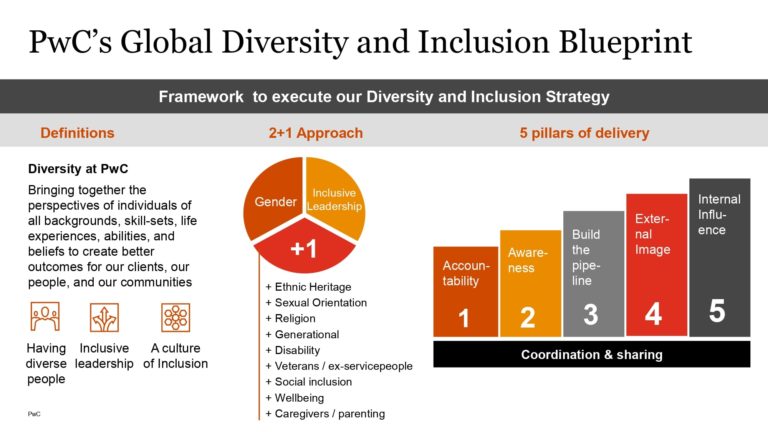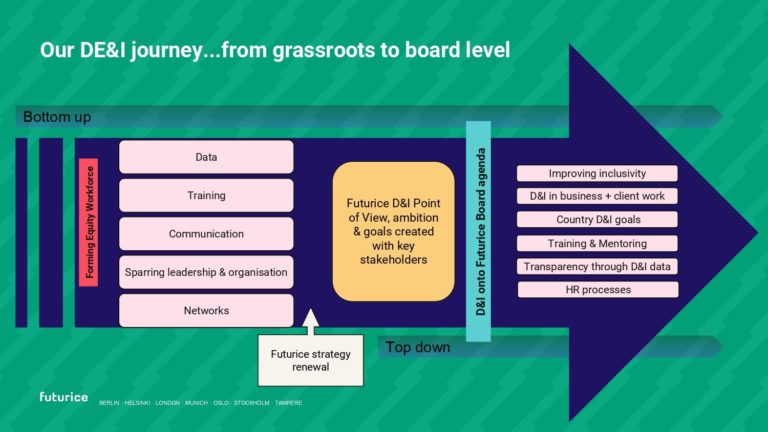3 Finnish companies promoting Diversity & Inclusion (D&I) in the workplace
How are successful Finnish companies promoting Diversity & Inclusion (D&I) in their workplace and how is it helping them to be highly competitive and to grow internationally?

But how about companies that have already successfully developed a Diversity & Inclusion (D&I) strategy and are promoting Diversity in Finland?
As the Nordic Business Diversity Index 2021 has recently revealed, we still need to put some effort into promoting Diversity in the workplace, both in Finland and in the Nordics.
2020 has been, for many aspects, a very tough year, but it has also highlighted some important issues, such as gender-gap, discrimination, and biases in workplaces.
Some companies took a stand and not only started implementing or promoting Diversity & Inclusion (D&I) in their organization, but also decided to embed it into their strategic measurable goals.
Through the IWWOF Talks Business series (available on the IWWOF YouTube channel), our CEO Priyanka Banerjee had the chance to discuss the very successful and thorough Diversity & Inclusion (D&I) frameworks that companies such as KONE, PwC Finland, and Futurice have developed and embedded in their company strategy. In the series, we had the pleasure to learn more about the companies directly from their very own experts: Kaija Bridger (Head of Talent and Culture, KONE), Helén Jensen (Director, PwC Finland), Sanna-Maria Lanki (Senior Manager, PwC Finland), and Heidi Pech (Head of DE&I, Futurice). Here, we summarized the highlights of their insightful presentation: are you curious already? Let’s have a look!
#1 KONE
KONE has been working in order to promote diversity in the workplace for quite some time now, and it has already received many acknowledgments worldwide (Financial Times, Forbes) for its commitment to Diversity & Inclusion (D&I) in terms of leadership and HR policy.
However, as Kaija Bridger (Head of Talent and Culture at KONE) highlights, consistency on the Diversity & Inclusion (D&I) matter throughout the whole organization can be challenging, especially in such a big company operating in over 60 countries and counting over 60.000 employees. For KONE it has therefore been very important to create a company-wide shared Diversity & Inclusion (D&I) vision:
Diversity makes us unique; Inclusion makes us powerful. At KONE, we strive to build and nurture an inclusive culture that promotes and values diversity. This drives our innovation and connects us closer to the customers and communities we serve.
This particular framework is very effective, allowing the analysis to be company-wide and covering all the different functions; furthermore, it can also be extended to suppliers and external organizations that work together with KONE, highlighting once again the importance of aligning the Diversity & Inclusion (D&I) goals across all levels.
The data-driven results of the assessment delivered a clear picture of KONE’s strengths as well as its areas of improvement. The key recommendations for KONE to get to the next level in Diversity & Inclusion (D&I) globally were:
- Treat Diversity & Inclusion (D&I) as a strategic business priority, and not as an HR priority;
- Focus systematically on talent pipeline;
- Engage leadership to build an inclusive culture.
Lastly, KONE advocates the importance of diversity as driving force for innovation, bringing its very own example:

Interested in learning more about KONE’s journey? You can find here the full IWWOF Talks Business with KONE recorded session.
#2 PwC Finland
As mentioned before, 2020 was the year in which many companies implemented or built a new strategy with the goal of taking more into consideration the structural changes and general uncertainty that our society and the workplaces were (and still are) experiencing.
This is also PwC Finland’s case: from July 2020 the company built a new 4-year strategy, based on PwC’s global purpose and core values. PwC Finland’s purpose is to build trust in society and solve significant problems; their services include management consulting, M&A services, tax advice, legal services, risk management, auditing, and other assurance services. In Finland, they can count on more than 1,200 employees (53 % female and 47 % male experts).
PwC Finland’s new strategic plan consists of 4 strategic focus areas, one of which is “Caring for people”. “Care” has always been part of PwC’s core values; however, it turned out to be so important for the company that they decided to elevate it and embed it into the strategy, too. Within the concept of “Care”, PwC addresses the significant aspect of acknowledging the power of a diverse workforce and creating a great workplace for diverse talent.
Diversity & Inclusion (D&I) is indeed a very heart-felt topic for this company, and it is for this reason that the PwC Global D&I Council was created, with the specific task of making sure that PwC will always live up to the set Diversity & Inclusion (D&I) standards in all offices across the world.
The framework through which PwC Finland is promoting Diversity & Inclusion (D&I) is very interesting:

The Diversity & Inclusion (D&I) strategy is framed into three different dimensions:
- The meaning of Diversity & Inclusion for PwC;
- A 2+1 approach that defines the specific aspects that are the focus of the strategy
- The steps that are necessary in order to reach the end-goal of creating a diverse and inclusive workplace.
The 2+1 approach is quite interesting as it varies depending on the country: 2 aspects (Gender and Inclusive Leadership) have been decided on a global level and represent a “must” for each regional branch, whereas 1 aspect can be chosen locally among the ones listed. PwC Finland, at the moment, decided to prioritize Sexual Orientation as a third dimension.
Clearly, this approach doesn’t make the other aspects (such as Ethnic Heritage, Religion, Disability, etc.) less important or forgettable! As PwC Finland’s Director Helén Jensen affirms, it is not realistic for the company to “fix it all at once”: one needs to start from somewhere, identifying the basis that is important for the company and that resonates with the employees, in order to grow further from that starting point and implement the strategy.
Interested in learning more about PwC Finland’s strategy? Click here to watch the full IWWOF Talks Business with PwC recorded session.
#3 Futurice
Futurice as an organization aims to grow and transform our team in such a way that we represent the diversity of the people in our field of impact (employees and leadership, clients, customers of our clients, talent market of today and the future).
Inclusion is an ongoing practice that allows everyone to participate and contribute as their whole selves. Respecting, celebrating, leveraging our differences. All individuals have a combination of different dimensions of diversity, and cannot be reduced to simply one factor. We are seeking intersectional diversity, diversity of thought, and representation.
Being aware of the fact that one cannot just solve all the issues all at once, Futurice decided to rather be effective and prioritize in order to implement meaningful changes. They have therefore selected gender (and specifically increasing the proportions of women within the company) and nationality as primary dimensions on which they will focus.
Diversity, Equity & Inclusion (DE&I) is, since summer 2020, part of the company’s business strategy; simultaneously, Futurice created 3 measurable goals that will help them in achieving their ambitions in the D&I field in the next 4 years:
- Become a completely inclusive workplace: close the fair treatment and inclusion gap between genders by 2024 (and half it by the end of 2021);
- Become the first choice for tech women: by 2024 have 33% women across all career levels in tech competence;
- Counting on a leadership that mirrors Futurice: diversify by 2024 the leadership teams, which will reflect diversity in terms of gender and nationalities according to the organization they lead.
It is important to highlight that Futurice’s commitment toward Diversity & Inclusion (D&I) started with a handful of employees, belonging to different European offices, who were very passionate and cared really strongly for this topic. They got together as a “grassroots team” and decided they had to do something about it in their own company, and they were actually able to achieve significant goals, such as the introduction of inclusive leadership training that all the leaders had to go through. These types of activity belong to the “Bottom-up” approach that you can see in the picture below (which explains how Futurice is promoting Diversity & Inclusion (D&I) in the workplace).

After working together with the leadership, Futurice has also implemented a “Top-down” approach, with Diversity & Inclusion being part of the company strategy and of the Board Agenda. Finally, on the right-hand side, you can find the steps Futurice believes are going to help the company achieve the goals it has set.
One of the activities initiated by Futurice’s grassroots team was to conduct a D&I audit through an external provider:

From this, it is clear that inclusion plays a big role within Futurice’s Diversity & Inclusion (D&I) strategy and it is at the core of the D&I training. The main activities promoted by the company are various, and among them you can find:
- Inclusive leadership training: for all the people who work as a team leader, in company leadership and in HR across all Futurice’s offices;
- Unconscious bias in recruitment workshop: for people who are heavily involved in the recruitment process, both in HR roles as well as in business. Focus on discovering own personal biases as well as those in the company’s recruitment process;
- Inclusion session during onboarding: within a few months when starting to work at Futurice, all the new starters go through an Inclusion workshop focused on how to practice inclusive behaviors with practical exercises.
Interested in learning more about Futurice’s strategy? You can find here the full IWWOF Talks Business with Futurice recorded session.
Key takeaways:
- Companies that are thriving in their field have dedicated a lot of time, thought, and effort into developing and promoting a Diversity & Inclusion (D&I) strategy, that could be strategically embedded into the company goals;
- For these companies, there is no doubt that a diverse set of talent is beneficial in terms of innovation and productivity (why would they even put so much effort in it otherwise?);
- There is no magic trick: you need to be consistent and start from somewhere. You cannot expect a workshop to transform your company culture, but at the same time you just need to give it a chance and implement even small changes in the process;
- You don’t have to stop working on the topic when you think you have a “diverse enough” workforce, because it is precisely then that you need to work on inclusion and retention of the talent you have;
- You cannot fix it all at once: you will have to prioritize some dimensions that resonate the most with your specific case and start from there. Is it religion? Ethnic heritage? Sexual orientation? Gender? Analyze your situation through a data-driven assessment and identify your pain-points!
About the author:

Aurora Grion is the Inclusive Marketing Specialist at BusinessWiz and a Diversity, Inclusion, and Cultural Studies enthusiast. She has been living and working in 4 different countries in the last 5 years and has therefore a very concrete take on Diversity & Inclusion (D&I) in workplaces, especially when it comes to inclusion of international talent.
Aurora holds a MA cum laude in Cultural Management and is the Vice-President of +Collective, an organization which promotes equality and inclusion in Finland through events and media production.

